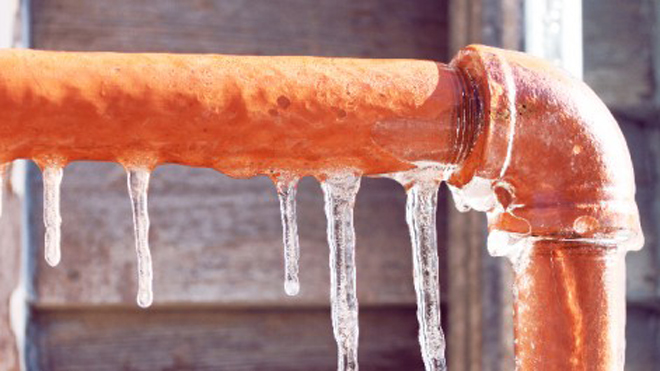The writer is making a few great annotation about How to prepare your home plumbing for winter weather as a whole in this great article on the next paragraphs.

Winter can ruin your plumbing, specifically by freezing pipes. Right here's how to stop it from taking place and what to do if it does.
Intro
As temperatures decrease, the danger of frozen pipes rises, potentially causing pricey repair work and water damages. Comprehending just how to avoid frozen pipes is critical for home owners in cold environments.
Recognizing Frozen Pipelines
What causes pipes to freeze?
Pipes freeze when revealed to temperatures listed below 32 ° F (0 ° C) for expanded periods. As water inside the pipelines freezes, it increases, taxing the pipeline wall surfaces and potentially triggering them to break.
Dangers and problems
Icy pipelines can bring about water supply interruptions, building damages, and costly fixings. Burst pipelines can flooding homes and create considerable structural damages.
Indications of Frozen Pipes
Identifying icy pipelines early can prevent them from rupturing.
Just how to identify icy pipelines
Try to find lowered water circulation from taps, uncommon smells or noises from pipes, and noticeable frost on revealed pipelines.
Avoidance Tips
Insulating susceptible pipelines
Wrap pipes in insulation sleeves or utilize warmth tape to safeguard them from freezing temperatures. Concentrate on pipes in unheated or exterior areas of the home.
Heating strategies
Maintain interior rooms properly heated up, especially areas with pipes. Open closet doors to permit warm air to flow around pipelines under sinks.
Protecting Outdoor Pipes
Garden tubes and outside faucets
Disconnect and drain garden pipes prior to winter season. Install frost-proof faucets or cover outdoor taps with protected caps.
What to Do If Your Pipes Freeze
Immediate actions to take
If you suspect frozen pipelines, maintain taps open to eliminate stress as the ice melts. Make use of a hairdryer or towels taken in warm water to thaw pipes slowly.
Long-Term Solutions
Architectural changes
Take into consideration rerouting pipelines away from outside wall surfaces or unheated areas. Include additional insulation to attic rooms, cellars, and crawl spaces.
Upgrading insulation
Buy high-grade insulation for pipes, attic rooms, and wall surfaces. Proper insulation aids keep consistent temperatures and reduces the risk of icy pipes.
Final thought
Avoiding frozen pipes needs aggressive steps and fast feedbacks. By comprehending the reasons, signs, and preventive measures, home owners can protect their plumbing during winter.
6 Proven Ways to Prevent Frozen Pipes and Protect Your Home
Disconnect and Drain Garden Hoses
Before winter arrives, start by disconnecting your garden hoses and draining any remaining water. Close the shut-off valves that supply outdoor hose bibs and leave the outdoor faucet open to allow any residual water to drain. For extra protection, consider using faucet covers throughout the colder months. It’s also important to drain water from any sprinkler supply lines following the manufacturer’s directions.
Insulate Exposed Pipes
Insulating your pipes is an effective way to prevent freezing. Pipe insulation is readily available at home improvement stores and is relatively inexpensive. Pay close attention to pipes in unheated areas such as the attic, basement, crawl spaces, or garage. Apply foam insulation generously to create a buffer against the cold. You can also wrap your pipes in heat tape or thermostat-controlled heat cables for added warmth.
Seal Air Leaks
Inspect your home for any cracks or openings that could let in cold air. Seal any holes around the piping in interior or exterior walls, as well as the sill plates where your home rests on its foundation. Additionally, make sure to keep your garage door closed unless you’re entering or exiting. Leaving it open creates a significant air leak that can lead to frozen pipes.
Allow Warm Air Circulation
During cold snaps, it’s essential to allow warm air to circulate evenly throughout your home. Leave interior doors ajar to promote better airflow. Open kitchen and bathroom cabinets to help distribute heat consistently around the rooms. If you have small children or pets, be sure to remove any household chemicals or potentially harmful cleaners from open cabinets for safety.
Let Faucets Drip
A small trickle of water can make a big difference in preventing ice formation inside your pipes. When temperatures drop significantly, start a drip of water from all faucets served by exposed pipes. This continuous flow helps prevent the water from freezing. Additionally, running a few faucets slightly can relieve pressure inside the pipes, reducing the chances of a rupture if the water inside does freeze.
https://choateshvac.com/6-proven-ways-to-prevent-frozen-pipes-and-protect-your-home/

As a keen reader on 6 Ways to Prevent Frozen Pipes, I think sharing that article post was sensible. So long as you enjoyed reading our page kindly consider to pass it around. I recognize the value of your readership.
Click Here